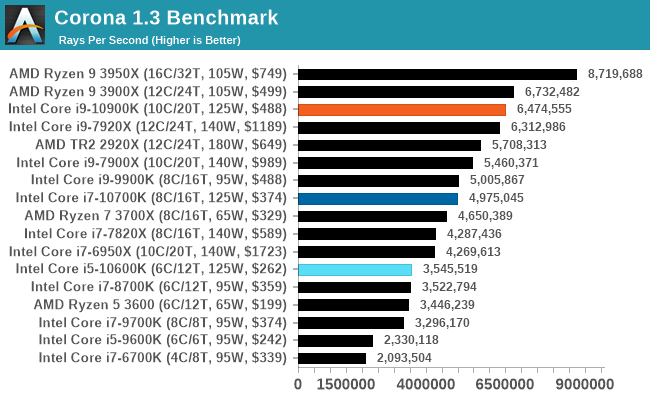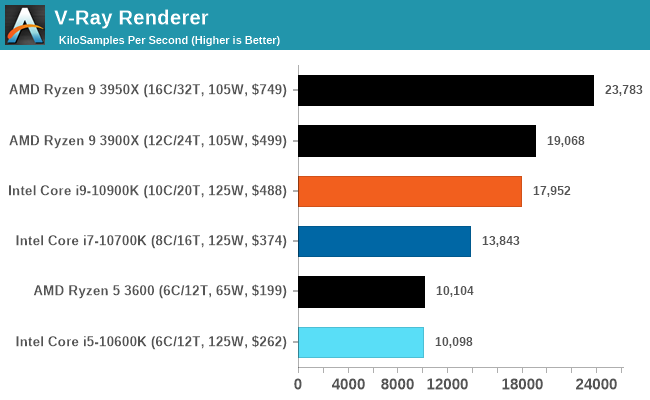The Intel Comet Lake Core i9-10900K, i7-10700K, i5-10600K CPU Review: Skylake We Go Again
by Dr. Ian Cutress on May 20, 2020 9:00 AM EST- Posted in
- CPUs
- Intel
- Skylake
- 14nm
- Z490
- 10th Gen Core
- Comet Lake
CPU Performance: Rendering Tests
Rendering is often a key target for processor workloads, lending itself to a professional environment. It comes in different formats as well, from 3D rendering through rasterization, such as games, or by ray tracing, and invokes the ability of the software to manage meshes, textures, collisions, aliasing, physics (in animations), and discarding unnecessary work. Most renderers offer CPU code paths, while a few use GPUs and select environments use FPGAs or dedicated ASICs. For big studios however, CPUs are still the hardware of choice.
All of our benchmark results can also be found in our benchmark engine, Bench.
Crysis CPU Render
One of the most oft used memes in computer gaming is ‘Can It Run Crysis?’. The original 2007 game, built in the Crytek engine by Crytek, was heralded as a computationally complex title for the hardware at the time and several years after, suggesting that a user needed graphics hardware from the future in order to run it. Fast forward over a decade, and the game runs fairly easily on modern GPUs, but we can also apply the same concept to pure CPU rendering – can the CPU render Crysis? Since 64 core processors entered the market, one can dream. We built a benchmark to see whether the hardware can.
For this test, we’re running Crysis’ own GPU benchmark, but in CPU render mode. This is a 2000 frame test, which we run over a series of resolutions from 800x600 up to 1920x1080. For simplicity, we provide the 1080p test here.
This is one of our new benchmarks, so we are slowly building up the database as we start regression testing older processors.

The Core i9-10900K scores 15 FPS at 800x600, which is just about playable.
Corona 1.3: Performance Render
An advanced performance based renderer for software such as 3ds Max and Cinema 4D, the Corona benchmark renders a generated scene as a standard under its 1.3 software version. Normally the GUI implementation of the benchmark shows the scene being built, and allows the user to upload the result as a ‘time to complete’.
We got in contact with the developer who gave us a command line version of the benchmark that does a direct output of results. Rather than reporting time, we report the average number of rays per second across six runs, as the performance scaling of a result per unit time is typically visually easier to understand.
The Corona benchmark website can be found at https://corona-renderer.com/benchmark

Blender 2.79b: 3D Creation Suite
A high profile rendering tool, Blender is open-source allowing for massive amounts of configurability, and is used by a number of high-profile animation studios worldwide. The organization recently released a Blender benchmark package, a couple of weeks after we had narrowed our Blender test for our new suite, however their test can take over an hour. For our results, we run one of the sub-tests in that suite through the command line - a standard ‘bmw27’ scene in CPU only mode, and measure the time to complete the render.
Blender can be downloaded at https://www.blender.org/download/

V-Ray
We have a couple of renderers and ray tracers in our suite already, however V-Ray’s benchmark came through for a requested benchmark enough for us to roll it into our suite. We run the standard standalone benchmark application, but in an automated fashion to pull out the result in the form of kilosamples/second. We run the test six times and take an average of the valid results.
This is another one of our recently added tests.

POV-Ray 3.7.1: Ray Tracing
The Persistence of Vision ray tracing engine is another well-known benchmarking tool, which was in a state of relative hibernation until AMD released its Zen processors, to which suddenly both Intel and AMD were submitting code to the main branch of the open source project. For our test, we use the built-in benchmark for all-cores, called from the command line.
POV-Ray can be downloaded from http://www.povray.org/

Interestingly the Core i9 with only 10C outperforms the 12C Ryzen 9 3900X here, likely due to the higher sustained frequency of the Intel chip. We clocked 220W on our Intel chip for this test however, well beyond the 120W of the AMD processor.












220 Comments
View All Comments
schujj07 - Wednesday, May 20, 2020 - link
That doesn't make any sense. The Crysis CPU render is new as of the Ryzen 3300X review from 2 WEEKS ago. https://www.anandtech.com/show/15774/the-amd-ryzen...catavalon21 - Wednesday, May 20, 2020 - link
AMD is shown leading in many CPU tests dollar for dollar or watt for watt.Achaios - Wednesday, May 20, 2020 - link
Chipzilla, due to its greed, got us back to the Heat Output of 2008 processors such as the Yorkfield QX 9650.Lookup "Overclocking Intel's New 45nm QX9650: The Rules Have Changed" by Anandtech, and check the thermal output of the QX 9650.
I don't see why any enthusiast would buy these overpriced and bad cpus. I certainly won't.
t.s - Wednesday, May 20, 2020 - link
Never underestimate intel fanboys. This statement is copied from fb comment section about Ryzen 4000 will have 20% IPC uplift rumour:"AMD is made for applications like streaming. Intel is made for the other 90% of the market that relies on the single core performance. Yes, most of the industry still relies on Single core performance. Maybe know your industry before making a comment"
tipoo - Wednesday, May 20, 2020 - link
TIL I'm a streamer. I didn't think data science was all that interesting!Cooe - Wednesday, May 20, 2020 - link
Seems Intel took a good hard look a the FX-9590 and was like... "Yup. Let's do that. It'll work for sure this time, I promise!"WaltC - Wednesday, May 20, 2020 - link
Bingo...;)plonk420 - Wednesday, May 20, 2020 - link
a) thanks for showing core to core latencies! b) so this doesn't have TSX?Calypto - Wednesday, May 20, 2020 - link
Why not throw in a Coffee Lake inter-core latency chart for comparison?Calypto - Wednesday, May 20, 2020 - link
ignore me I'm stupid